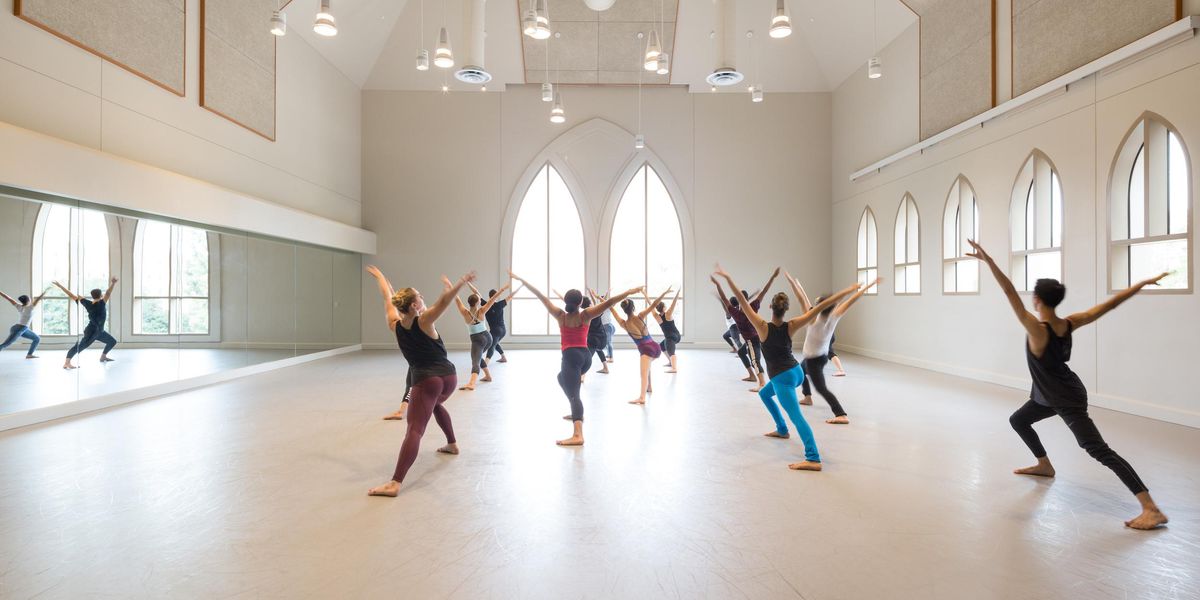Making His Own Rules
For
Jonah Bokaer’s latest groundbreaking work, pop musician Pharrell Williams joins the choreographer’s list of high-profile collaborators.
Arching to the ground: Wendell Gray (top) and James McGinn rehearse Bokaer’s slow-motion fight scene from Rules Of The Game. Photos by Jim Lafferty.
“The distance between what you intend and what you get—try to tighten it up,” Jonah Bokaer says quietly. It’s a very Bokaer-like way of asking for more precision as he aims for high-definition visual crispness in a series of rapid-fire boxing jabs and blocks. His two dancers nod and reset, both settling into a wide parallel second.
Their fight starts in painstaking slowness, one dancer constantly interrupting the other’s stance with a toe lifting behind a knee. Then a break in the music shatters the meditative calm. They suddenly throw each other into the air, drop to the floor, just avoid a painful collision with a well-timed roll—until the pace shudders almost to a halt, one dancer caught by the other’s hand at his throat, ascending to relevé
and arching back to the ground as though someone hit the slow-motion button.
They’re rehearsing
Rules Of The Game, Bokaer’s much buzzed-about contemporary dance work set to appear at Brooklyn Academy of Music this month after premiering at the SOLUNA International Music & Arts Festival in Dallas in May. The piece celebrates the 10-year-long creative partnership between Bokaer and contemporary artist Daniel Arsham. For the past decade, the two have approached their work as cohesive visual art, rather than dance plus backdrop. For example, in Bokaer’s 2010 solo RECESS (set to appear at BAM on the same program), a massive roll of paper, conceived of by Arsham, is the dancer-choreographer’s partner onstage—the scenography is inextricable from the choreography. “I like injecting new things into dance,” says Bokaer, whose unexpected multimedia projects have taken him everywhere from New York’s MoMA PS1 to an interactive iPad app.
Rules, however, is their biggest project to date, and brings the addition of new collaborators: Grammy Award–winning musician Pharrell Williams and arranger-orchestrator-conductor David Campbell. It was described as “a brand-new medium” in Rolling Stone. “If that’s true, then I’m very honored!” Bokaer says with a laugh. “But I think people have collaborated with composers and visual artists for a very long time.” The piece is Williams’ first commissioned score for a dance work; it maintains the upbeat groove that characterizes his work in pop music but is lent an epic feel by Campbell’s arrangement for the Dallas Symphony Orchestra (a special mastered recording will be used for the performances at BAM and on tour). Rules also marks Arsham’s first use of film in one of Bokaer’s pieces, with a video of objects falling and shattering in slow motion to be projected onto the back wall of the stage, mirroring actual objects with which the dancers interact.
“Usually when a piece is just out of the oven it’s very exciting, but there’s a sort of racing to the finish line that happens,” says Bokaer. “It’s when you can tour—and we’re blessed with a very robust tour here, on three continents—it’s usually on the repeated performances of it that the work settles in and you start to lock in incredible performances.”
Today, Bokaer is only working with two of the eight dancers: James McGinn, of the original cast, and Wendell Gray, a new hire. Bokaer occasionally consults performance footage on his laptop, pointing out details and music cues, but mostly he joins the two dancers in the center. Although he won’t perform in this piece, he steps in for multiple missing cast members, his long limbs and beautifully arched feet folding and spiraling easily through the hypnotically organic work, pausing every so often to retrace a sequence for Gray. “Allow the plane of your pelvis to tip—you only need to move what you need to,” he instructs calmly from upside down as he supports his weight on his hands.
Later, seated at the s
ide of the studio, Bokaer tells an interviewer, “When you get eight extraordinary people together and they’re all pushing themselves…” he trails off momentarily, eyes sharpening as he focuses on McGinn and Gray running a phrase. He picks up the thought exactly where he had left it to continue, “…then it’s a part of why you see the performances that you see, these knockout men and women.”
The break in attention is unusual for the hyper-focused Bokaer, yet it seems to encapsulate both his conversation and his choreography.
Nothing is superfluous, the details are clearly stated and precisely defined; the speed at which they unfold shifts drastically but never halts its forward momentum. With his highest-profile collaboration yet under his belt, there’s no telling where making—and breaking—his own rules will take him next.
Courtney Escoyne is an assistant editor at Dance Magazine.




